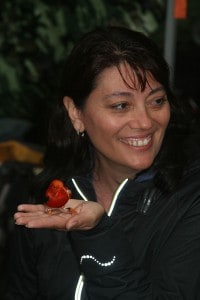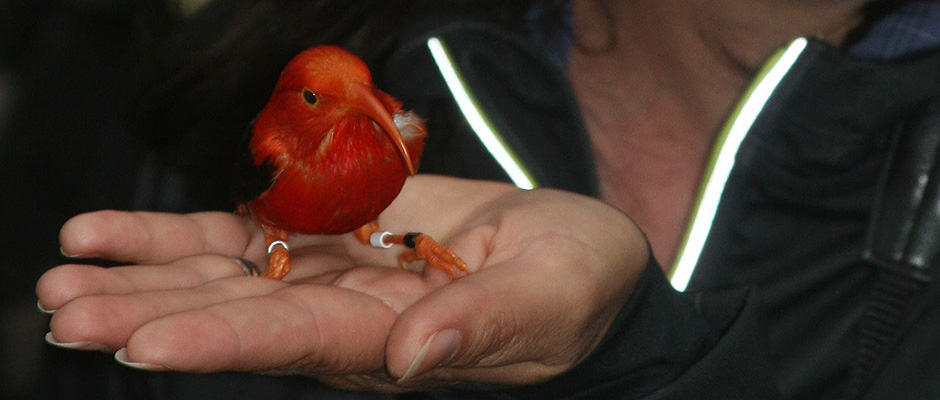Share this article
TWS Chats with New National Wildlife Refuge System Chief
Last week, the U.S. Fish and Wildlife Service announced the appointment of Cynthia Martinez as the new chief of the National Wildlife Refuge System — a system that provides habitat for more than 700 species of birds, 220 species of mammals, 250 reptiles and amphibian species, and more than 1,000 species of fish.
As part of her new role, Martinez, who has been with the agency for 21 years, will lead the management of public lands and waters set aside with the purpose of conserving America’s fish, wildlife and plants.
We caught up with Martinez to learn more about her experiences and goals for the future as chief of the Service’s Refuge System.

Cynthia Martinez, the newly selected chief of the National Wildlife Refuge System, holds an endangered Hawaiian forest bird called an I’iwi (Vestiaria coccinea) at a USGS bird banding station in Hakalau Forest National Wildlife Refuge, HI. When other people held the birds, they flew out of their hands immediately, but the little red bird seemed content in stuck around in the palm of Martinez’s hand.
Image Credit: USFWS
Q: What was your career path, and how did you get to where you are today?
A: I started with the Service as a contaminants biologist in the Phoenix Ecological Services Fields Office. From there, I moved to the Southern Nevada Ecological Services Office in Las Vegas, Nevada, as a fisheries biologist. For 15 years, I held several positions from working in fisheries to field supervisor. I then became refuge manager at the Desert National Wildlife Refuge Complex in southern Nevada. In that complex, there were four national wildlife refuges that I was responsible for: Desert, Ash Meadows, Moapa Valley and Pahranagat national wildlife refuges. I then came to the headquarters as chief of the Division of Visitor Services and Communications. In January 2012, I became deputy chief of the Refuge System. And then, as of May 11, I was selected as chief.
Q: What sparked your interest in wildlife and conservation/management?
A: I am a native of New Mexico. My family has been there for a long time, and I am the fifth generation of New Mexicans in my family. Before New Mexico was even part of the United States, I had deeply rooted tradition there and in the culture. Many of my family activities growing up were done outside, including fishing in New Mexico’s rivers. This gave me a general connection to the outdoors.
I graduated from New Mexico State with a bachelor’s of science in general biology. Then, I went to University of Arizona and got a master’s of science in fisheries and wildlife science.
My connection to nature has a lot to do with fishing. I have two children now — a 13-year-old daughter and a 10-year-old son. They get a kick out of fishing. My daughter hates the taste of fish, but she sure likes to fish. To feel that first little tug on the end of the line — it’s an amazing feeling you never ever forget. What kid doesn’t like water? I have a huge connection to fishing and to water, and I tried to instill some of that in my own kids.
Q: What are your goals as the new Chief of the National Wildlife Refuge System?
A: Shortly after passage of the National Wildlife Refuge System Improvement Act of 1997, the Service set forth a strategic vision for the Refuge System in 1998. It was called “Fulfilling the Promise,” and in it we identified our priorities and what we’re going to work on. If you fast forward to 2010, we began the process of revisiting the strategic vision of the Refuge System. We realized that a lot has changed in this country. In fact, we didn’t reference climate change in the earlier vision. In the new process, we recognized that demographics are changing, and people are becoming more urban. Yes, we’re introverted biologists. But unless we make a connection with people, we can’t successfully do our job with wildlife management.
We developed a new strategic vision called “Conserving the Future: Wildlife and the Next Generation.” Since 2011, we put together implementation teams, and so far, many different policies have come out of this. We also made a commitment to urban areas and to reconnecting with people. As chief, my plan is to continue implementing “Conserving the Future.”
Q: What are you most excited about in your new position?
A: I’m most excited getting to see these great places and meeting the folks on the ground doing these jobs. I embrace the national perspective and will be trying to influence those things we do at the national level to guide what we do on the ground.
We work in these majestic places, and I think it’s important to connect with people so our employees can share their passion for what they do and the wild things and places they are entrusted with. We have to do as much as we can to give folks the tools that they need to make these connections.
TWS and the National Wildlife Refuge System
The Wildlife Society actively engages and supports the National Wildlife Refuge System and the wildlife professionals who work in the refuges. We are involved in the Cooperative Alliance for Refuge Enhancement (CARE), which focuses on achieving adequate appropriations for the refuge system. We also work independently and with partners like the National Wildlife Refuge Association to ensure that legislation and administrative rules support the identified mission of National Wildlife Refuge System and enable the dedicated professionals who implement management on those properties.
Header Image:
An endangered Hawaiian forest bird called an I’iwi (Vestiaria coccinea) at a USGS bird banding station in Hakalau Forest National Wildlife Refuge, HI.
Image Credit: USFWS








